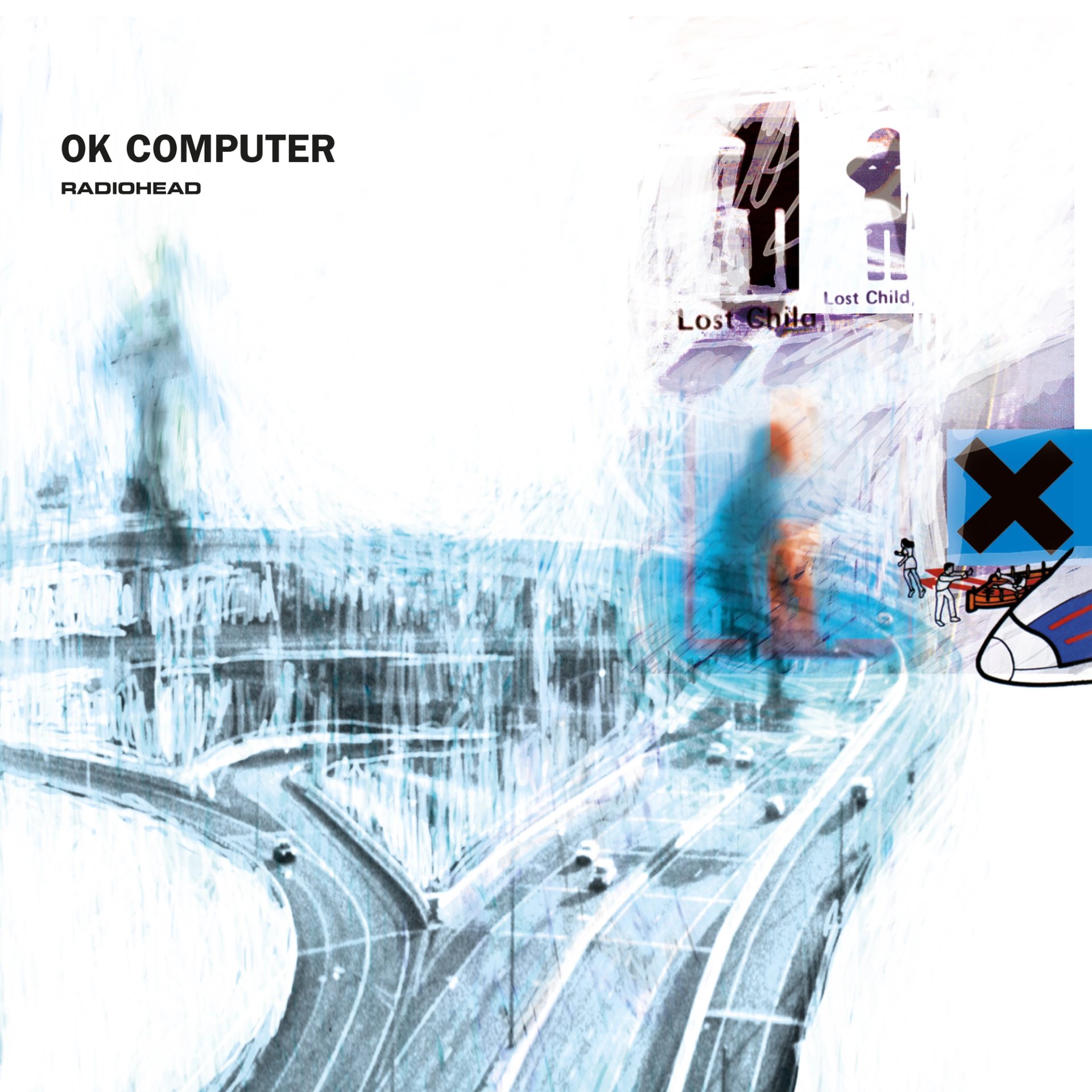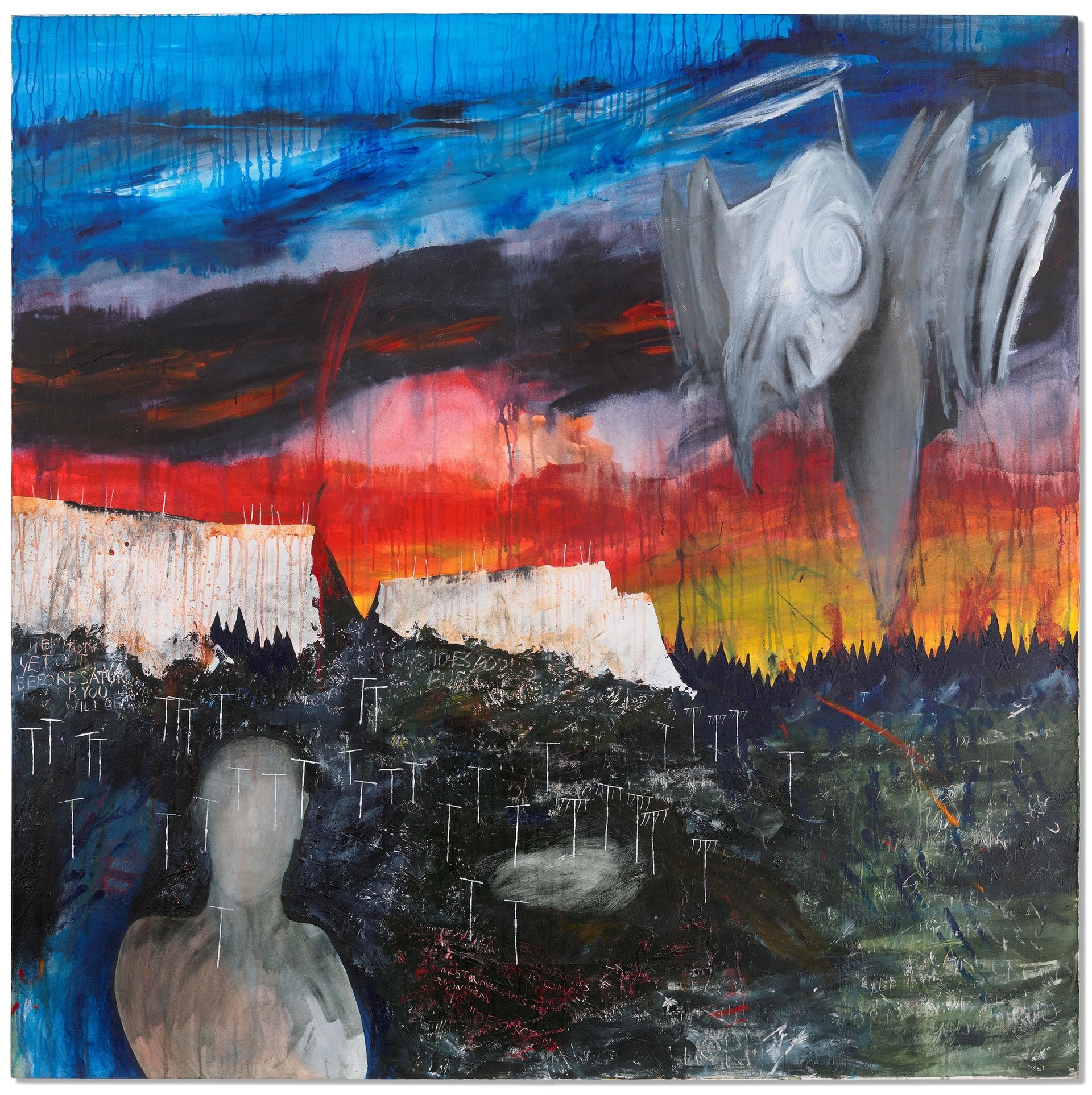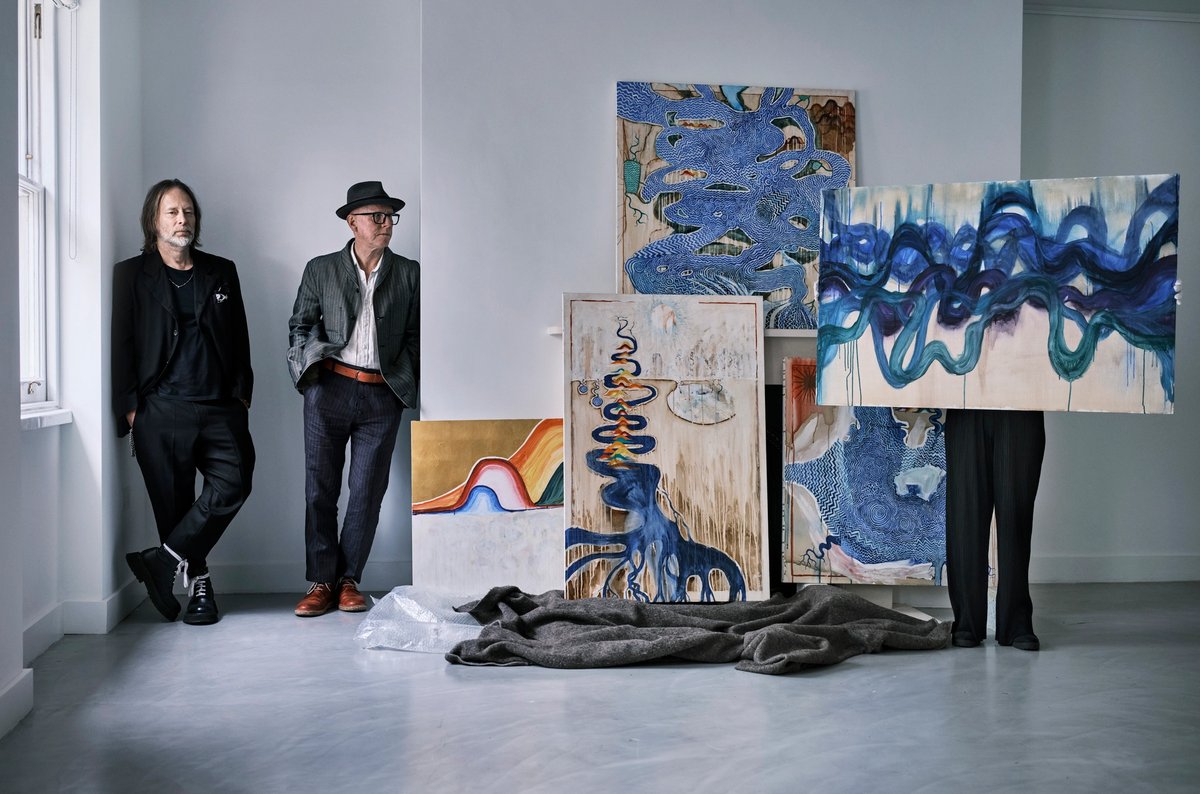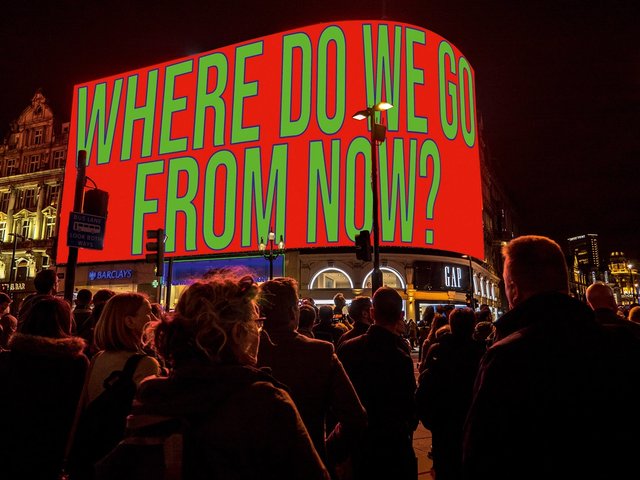“It feels like just last year we were standing in HMV in Oxford thinking about how we were going to do a record sleeve and now we’re doing a museum show in pretty much the same spot,” says Stanley Donwood, the artist who is considered the sixth member of the British band Radiohead.
That first album sleeve, of a gasping resuscitation dummy, was created 30 years ago for The Bends and now Donwood (whose real name is Dan Rickman) and Radiohead frontman Thom Yorke are due to have their first institutional show, opening next August at the Ashmolean Museum in the band’s hometown of Oxford. Titled This is What You Get, a lyric from the wildly popular song Karma Police, the exhibition will include most of Radiohead’s album art from the past three decades, as well never publicly seen archives of sketchbooks, notebooks and faxed correspondence between Yorke and Donwood. Paintings and other works created for Yorke’s solo projects and his offshoot band, The Smile, are also due to go on show.
Donwood—who is now based in Brighton after finding Bath had become “too boring”—and Yorke first met at the University of Exeter where they were studying fine art and English literature. Rather than the paint-splattered studios of the art department, both were drawn to the smart graphic design department and its burgeoning technologies of the time. “We spent most of our time in graphic design, because that’s where they had a couple of those tiny little Apple Mac computers,” Donwood recalls.
The pair were reunited around a year after they graduated; Donwood had taken up fire breathing and was hitchhiking and busking around the country when he stopped again in Oxford and saw a poster for On a Friday, as Radiohead was then known, who were playing at the Jericho Tavern. “My friend Jim and I were going to be their support act and we were like, ‘excellent, fame!’. But the landlord wasn’t having any of it,” Donwood says. It was not until a few years later that Yorke phoned Donwood: “He asked if I wanted to have a go at doing a record sleeve and I said ‘yeah, alright’. So, I got the train to Oxford and we started.”
That was 1993 and technology was again on the band’s mind. Donwood and Yorke would go out and take photographs and then film the developed pictures and play them on a television, only to photograph the moving images again. They had the idea to shoot an iron lung— the title of a song from The Bends—after gaining access to the John Radcliffe Hospital in Oxford, but they found the grey metal box visually underwhelming. In a dimly lit storage room, they stumbled on a resuscitation dummy, and Donwood immediately snapped that instead. “It was brilliant and quite fortunate as we had a really urgent deadline to submit the cover for the record,” he says.

Stanley Donwood and Thom Yorke, OK Computer (1997) Album cover © 1997 XL Recordings Ltd.
The ghostly, smudged cover image for OK Computer, the band’s third album, which propelled them to stardom, is based on a photograph of a highway interchange in Connecticut, apparently taken from the window of a Hilton hotel that Radiohead stayed in after a show in August 1996. Donwood had upgraded from a mouse to a tablet and stylus, which allowed him to draw as well as erase things digitally. But he and Yorke decided they were not allowed to use the “undo” function but had to instead rub out unwanted elements using a crude “wet edge” tool. “Totally erasing things felt like faking it, so we decided to just paint over them,” Donwood says. “We ended up making these layered pictures. It was an analogue technique using what was at the time the latest technology.”
The final artwork was achieved by scanning and layering various sketches and images over each other. As Yorke recalls in an interview with Lena Fritsch, the curator of the Ashmolean exhibition: “We could not believe how exciting it was to digitise […] A flatbed scanner was the most exciting thing ever invented in the whole universe, as far as we were concerned. It just sat there all the way through OK Computer, just scanning, scanning, scanning.”
In the late 1990s, Radiohead began working on their fourth album, Kid A in an abandoned cinema in Paris. Donwood had purchased his first laptop, which had a small trackpad. “I was using that to do all of the art work and I just got this terrible repetitive strain through my wrist,” he says. “It made me realise that it didn’t make any sense to draw like that—I wanted to use my arms and feet and everything.”
After Kid A, Donwood went supersize, working on canvases measuring six square feet. Among the bodies of work that he produced at that time were the Minos Wall paintings, loosely based on the myth of the minotaur. There are plans for three of the canvases to be shown in Oxford. Donwood had begun to paint with Artex, a kind of acrylic paste popularly used on ceilings during the 1970s and 80s. “I was applying it to canvases with palette knives, and then you could write in it when it was drying,” Donwood says. “I was imagining what it would be like to be a minotaur—half human, half monster and trapped in the dark. All you had were claws to scratch into the wall.”
While Donwood’s musical tastes veered more towards breakbeat and techno than the rock of Radiohead’s earlier albums, In Rainbows (2007) marked a turning point for the artist. “It’s a good’un. They definitely got better,” Donwood quips. The artistic process for the album sleeve was not so harmonious, however. Donwood had just read a “really depressing book about what happens to our civilisation when we run out of oil”, which he thought a “rich seam to mine”. So he began to create images of suburbia and exurbia, an American term that refers to residential areas outside of cities. “I was doing all this work, and they were all out in this really decaying stately home in Wiltshire, working on the music for In Rainbows,” Donwood says. “As it went on, the sounds were just becoming the total opposite of what I was doing. I had all these rigid perspectives, and the music was all fluid and sexy.”

Stanley Donwood and Thom Yorke Get Out Before Saturday (2000)
By complete accident, Donwood stumbled on an alternative idea when he spilt wax from a huge church candle over one of his intricate pencil drawings. “When it dried, the wax was this translucent white. It had this weird parallax effect of it looking like the drawing was on top of the wax. It was kind of brilliant,” he says. Donwood immediately went out and bought a stash of coloured wax pellets. “I had this mad laboratory with these wood burning stoves and fun little saucepans full of molten wax which I poured into hypodermic needles,” he says. “Wax is a great way to wreck a scanner.”
The final In Rainbows cover came together when the pair decided to layer text over the image. Texts and words have played a big part in Yorke and Donwood’s relationship. “One of the ways that Dan and I communicate, or have an affinity, is not necessarily just visual stuff. It's also the fact that we both work with words in different ways. That matters. I read what he writes, he reads what I write. Text often informs, directly or indirectly, what we’re trying to do,” Yorke says in his interview with Fritsch. The musician’s phone, he adds, is full of notes, words and overheard phrases—much of which never gets used.
Never illustrative of the music, and always collaborative, in more recent years Yorke and Donwood have produced art standing side-by-side. During the pandemic, they created a series of paintings for Yorke’s new band The Smile. “We worked in a shipping container in Thom’s garden, taking turns to paint,” Donwood says. “Thom’s better at chaotic, expressionistic stuff and I’m better at neat stuff.”
The idea, Donwood says, was to recreate the process behind botched fresco restorations. “I had this thing in my head about bad Jesus restorations,” he says. “But to do a bad Jesus restoration, you’ve got to have the stuff that’s being restored first, which has to be good. So you do the good stuff first and then fuck it up.”
One of Donwood’s biggest failures, he says, was when he tried to paint portraits of the band for the 2011 album, King of Limbs. “I had the genius idea that I’d paint in the style of Gerhard Richter using oil paints because I’d never painted the band before. But there was a good reason for that—I can’t paint portraits, I can’t use oil and I’m not Gerhard Richter,” Donwood says. “The oil paint wouldn’t dry and I just ended up with these brown paintings. It looked like a dirty protest from H block or something. It was really depressing.”
At the time, Radiohead was making music in a barn in Oxfordshire. “I was in this barn, listening to the music that became the King of Limbs, looking at all these huge timbers that the barn was constructed from and thinking about them growing and what had happened in the world since they germinated as acorns,” Donwood says. “And then I just thought, ‘my god, I’m going to go back out there and paint forests’.” The portraits were eventually painted over with trees and the cartoonish figures that have come to represent the album.
Much of the musicians' long and illustrious careers have existed in record shops rather than in the mainstream art world—as Yorke says: “I always feel that record covers are the things that happen on street corners, or they used to be, and they are there, in a way that the gallery is not.”
Now, however, there is a sense of breakthrough in the art world—and market. Yorke and Donwood have been working with the London- and Hampshire-based gallery TIN MAN ART since its opening in 2021. According to James Elwes, the gallery’s director, Christie’s agreed to exhibit and sell the works during London’s Frieze Week in October 2022 with a low estimate of £10,000-£15,000. “They sold for ten times that and suddenly there was a market,” Elwes says. The gallery has a show of new works including linocuts, lithographs, tapestries and paintings opening at 9 Cork Street on 29 November (until 14 December).
It has been an unorthodox route into the art establishment, but one that has worked for them, Donwood thinks: “It’s like the title of the Ashmolean show says—this is what you get when you have two ex-art students making record sleeves for 30 years. And just letting them get on with it.”
• Listen to Thom Yorke and Stanley Donwood discuss their forthcoming show on this episode of our The Week in Art podcast





